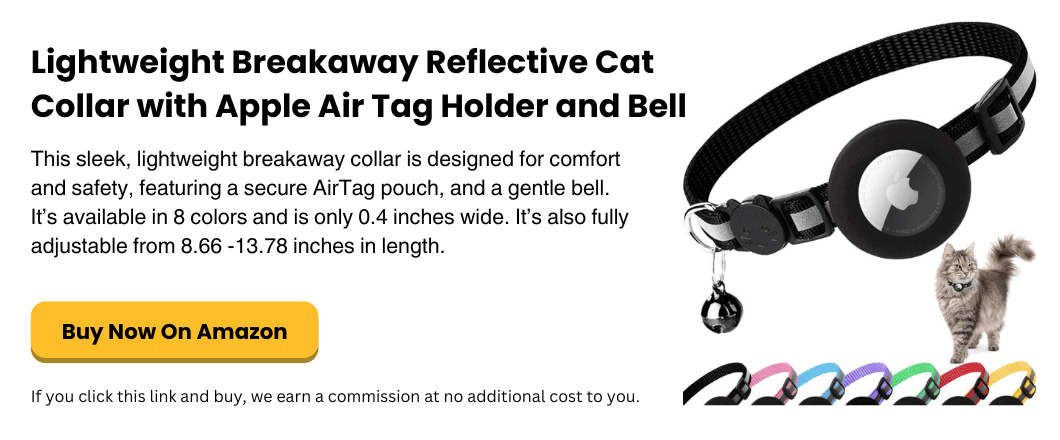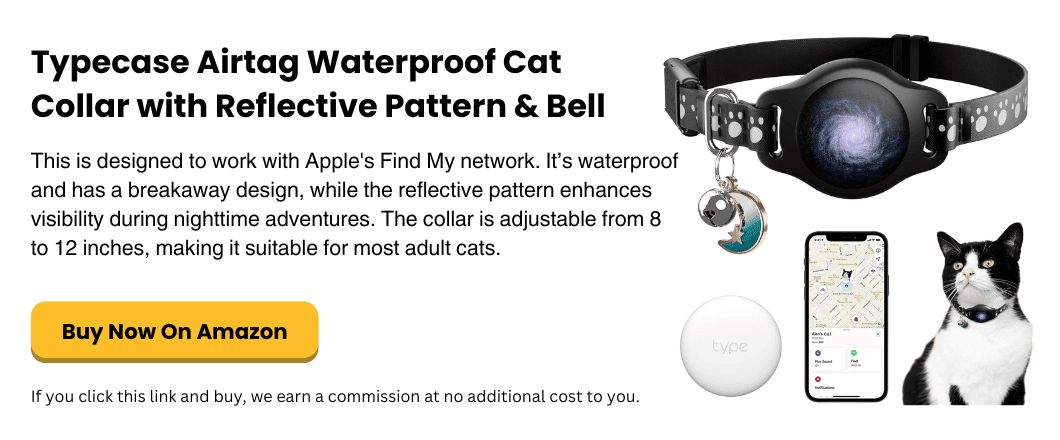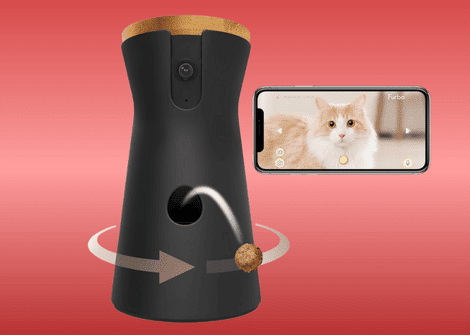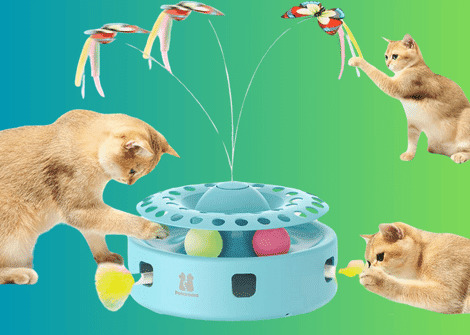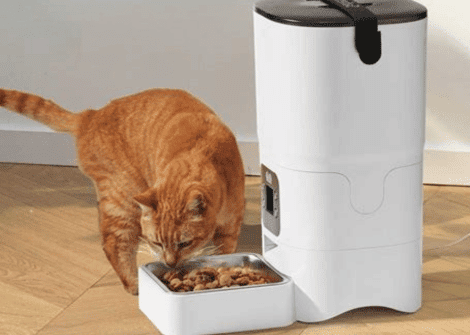GPS Cat Collars: The Complete Guide to Never Losing Your Cat
Every cat owner has probably experienced that heart-stopping moment when their cat doesn’t come home at their usual time – or when they disappear for far too long.
Well, there is a possible solution for this, in the shape of a GPS cat collar.
These smart devices let you track your cat’s location in real time, giving you peace of mind and a reliable way to find them and bring them home if they stray.
In this guide, we’ll walk you through everything you need to know about using a GPS collar to keep your cat safe—from understanding how it works, to choosing the right one, to training your cat to wear it comfortably.
Whether you live in a busy neighborhood or out in the countryside, using a GPS collar could be the safest step you take for your cat’s freedom and well-being.
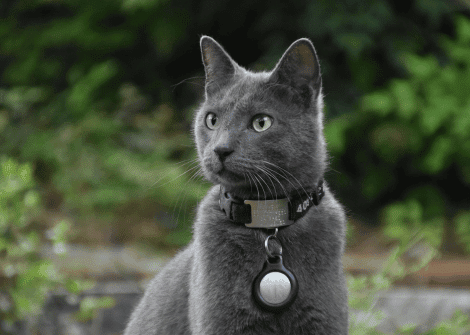
Table Of Contents
Why GPS Collars Are Important For Cat Safety
How GPS Collars Work
Choosing The Right GPS Collar For Your Cat
The Best GPS Cat Collars
Introducing Your Cat To Their GPS Collar
Understanding GPS Collar Limitations
Building A Comprehensive Cat Safety Strategy
What To Do If Your Cat Goes Missing
Frequently Asked Questions About GPS Cat Collars
Why GPS Collars Are Important For Cat Safety
As you are aware, cats are natural explorers with strong hunting instincts that can lead them far from home. Sometimes, this can lead them to becoming lost, unable to find their way back.
The statistics surrounding lost cats are sobering. According to the American Society for the Prevention of Cruelty to Animals, a quarter of all lost cats are never found or returned to their owners.
Traditional identification methods like tags and microchips are helpful when someone finds your lost cat, but they don’t help you actively locate a missing pet. GPS collars bridge this gap by providing continuous location tracking, allowing you to monitor your cat’s movements and quickly locate them if they wander too far or get into trouble.
A GPS collar allows you to monitor your cat’s location in real-time. This means you can quickly respond if your pet leaves a designated area, gets stuck somewhere, or stops moving unexpectedly. Some GPS systems also log activity, so you can see where your cat goes over time and recognize patterns in their behavior—helpful information if they begin visiting potentially dangerous locations, like busy roads or unfriendly neighboring yards.
Even beyond emergencies, a GPS collar helps build trust and freedom. You can allow your cat more independence with the reassurance that you can locate them any time. It’s a win-win for both feline freedom and responsible ownership.
How GPS Collars Work
A GPS collar typically includes a small tracking device that communicates with satellites to pinpoint your cat’s location. That location data is then sent to an app on your phone or computer. The result is a live map that lets you track your cat’s movements in near real-time.
Most collars fall into two main categories based on how they transmit location data.
The more common type uses GPS combined with a cellular connection, much like a smartphone. This setup usually requires a monthly subscription but offers the advantage of tracking your cat over a much broader area—perfect for outdoor cats in both urban and rural settings.
The second type uses radio frequency (RF) technology. These systems are usually subscription-free and involve a handheld receiver that picks up the signal from your cat’s collar. While more limited in range and sometimes less precise, RF trackers can be ideal for cat owners living in areas with poor cell reception.
Additional features found in many GPS collars include virtual boundaries (often called geofences), which alert you if your cat leaves a specific area, and health or activity tracking, which logs how much your cat is moving each day.
Choosing The Right GPS Collar For Your Cat
Choosing a GPS collar for your cat isn’t a one-size-fits-all decision. Many GPS collars are made to fit both cats and dogs. However, as you’re aware, cats are smaller, lighter, and more sensitive than dogs, so you’ll need to find something specifically designed for feline use.
Look for collars that are lightweight and low-profile. A bulky or rigid device may irritate your cat, or worse, pose a safety hazard if it catches on fences or branches.
Battery life is another important consideration. Some devices only last a day or two on a single charge, while others can go a week or more. Battery drain often depends on how frequently the GPS updates your cat’s location, so there’s a balance between tracking accuracy and power efficiency. Ideally, find a collar that allows adjustable update intervals to fit your needs and save the battery from draining too quickly.
Water resistance is also essential. Cats are notorious for squeezing into unexpected places, including wet shrubs, ponds, or even open drains. A splash-proof or waterproof design ensures that the collar remains functional regardless of your cat’s adventures.
Most importantly, the collar must be safe. Always choose one with a breakaway mechanism. This safety feature ensures that the collar will release if your cat gets it caught on a branch, fence, or other obstacle, preventing choking or injury. Losing a collar is inconvenient—but losing a cat to a preventable accident is tragic.
Also, the accuracy of GPS tracking depends on the technology used. Look for collars that combine GPS with other positioning technologies like Wi-Fi and cellular triangulation for improved accuracy in urban environments where GPS signals may be blocked by buildings.
The Best GPS Cat Collars
There are hundreds of GPS cat collars out there on the market, but we have taken all the features your cat’s collar needs and have come up with the Top 5 that we consider are the best you can buy.
Best Overall GPS Cat Collar
Best GPS Cat Collar With Activity & Wellness Monitoring
Best GPS Cat Collar For Kittens and Small Cats
Best RF Cat Collar With No Monthly Fees
Best GPS Cat Collar With No Monthly Fees
1. Best Overall GPS Cat Collar
The Dgerp Lightweight Breakaway AirTag Cat Collar is a popular option among cat owners looking to combine lightweight safety with smart tracking. Designed specifically to hold an Apple AirTag securely, this collar also features a breakaway buckle, reflective strips, and an audible bell. It’s a practical choice for anyone wanting a balance between low-tech safety features and high-tech tracking support.
Pros:
- Comfortably Lightweight Design: At just 0.4 inches wide and constructed with soft materials, this collar is ideal for kittens or smaller cats who may not tolerate heavier accessories. The slim build ensures it doesn’t irritate sensitive necks.
- Breakaway Safety Buckle: The collar includes a breakaway mechanism designed to release if your cat gets caught on a branch, fence, or other obstacle. This safety feature significantly reduces the risk of choking or injury during outdoor exploration.
- Reflective Strip for Visibility: Reflective stitching helps make your cat more visible at night or in dim lighting. This added visibility is a smart safety feature, especially if your pet roams near roads or driveways.
- Secure AirTag Holder: The integrated pouch holds the AirTag snugly and keeps it in place, minimizing the chance of it falling out during play or while your cat is climbing or running.
- Includes a Bell for Audible Tracking: A small, gentle bell is attached to help you hear where your cat is around the house or yard. It also gives a friendly heads-up to birds and other small animals.
- Water-Resistant and Durable Material: Made from sturdy nylon, the collar can handle some exposure to the elements, making it suitable for outdoor cats who may encounter rain, mud, or dew.
- Adjustable Fit for a Range of Sizes: The collar fits neck sizes from approximately 8.5 to 13.8 inches, allowing room for growing kittens or fitting a variety of adult cats without discomfort.
- Easy AirTag Insertion and Removal: Unlike some bulky designs, the holder is flexible and user-friendly, making it easy for owners to remove and reinsert the AirTag when needed for charging or replacement.
Cons:
- AirTag Sound Can’t Be Disabled: If you use the AirTag’s built-in “play sound” feature to help locate your cat, be aware that it can’t be permanently muted. Some cats may find the chirping noise stressful or annoying, especially if it is used frequently.
2. Best GPS Cat Collar With Activity & Wellness Monitoring
The Tractive Smart Cat GPS Tracker is a comprehensive location and wellness monitoring device designed specifically for cats weighing 6.5 pounds or more. This lightweight, waterproof tracker attaches to your cat’s collar and provides real-time GPS tracking through a smartphone app, combining location services with activity monitoring to help you keep tabs on your cat’s whereabouts and health.
Pros:
- Real-time GPS tracking: with consistent updates and reliable performance, allowing you to monitor your cat’s location anywhere with cellular coverage.
- Virtual fence feature: sends instant notifications when your cat leaves designated safe zones, providing peace of mind for outdoor adventures.
- Up to 7-day battery life: has power-saving features that extend usage by reducing updates when your cat is stationary.
- Cat-specific activity monitoring: designed to track sleep patterns, active time, and calorie expenditure, calibrated specifically for feline behavior.
- Bluetooth Find Mode: has sound and light activation to help pinpoint your cat’s exact location when you’re nearby, even indoors or in dense areas.
- Lightweight, comfortable design: that cats tolerate well for extended wear during day and night.
- Comprehensive location history and heat maps: see where your cat has been and their favorite spots.
- Waterproof construction: this ensures durability in various weather conditions.
Cons:
- Requires ongoing monthly subscription fees: these range from $5-13 per month depending on the plan and payment schedule, adding to the long-term cost.
3. Best GPS Cat Collar For Kittens and Small Cats
This Airtag Breakaway Cat Collar with Luminous & Reflective Fish Pattern is specifically designed for smaller cats and kittens. The collar is both functional and visually appealing for indoor and outdoor cats.
Pros:
- Safety-first breakaway design: the collar will release if your cat gets caught on something, preventing choking or injury while still keeping the AirTag secure during normal wear.
- Waterproof protection: keeps your Apple AirTag safe from rain, water bowls, and other moisture, ensuring consistent tracking functionality.
- Enhanced visibility features: the luminous and reflective fish pattern helps you spot your cat in low-light conditions and adds a fun decorative element.
- Lightweight construction: won’t weigh down your cat or cause discomfort during extended wear, making it suitable even for smaller kittens.
- Hidden AirTag compartment: keeps the tracker secure and protected while maintaining a sleek appearance that won’t snag on objects.
- Adjustable sizing: the 9-13 inch range accommodates cats of various sizes, from kittens to adult cats.
- Cost-effective tracking solution: works with Apple’s existing AirTag network, providing reliable location tracking without monthly subscription fees.
- Durable materials: built to withstand active cats and outdoor adventures while maintaining the collar’s integrity.
Cons:
- Requires separate AirTag purchase: you’ll need to buy an Apple AirTag separately, adding to the overall cost of the tracking solution.
4. Best RF Cat Collar With No Monthly Fees
The TabCat RF Breakaway Cat & Kitten Collar is a radiofrequency (RF) tracking system designed specifically for cats and kittens. Unlike GPS trackers, it uses directional homing technology to help you locate your feline companion within a 500-foot range. This makes it particularly effective for both indoor and outdoor searches without requiring cellular service or expensive monthly subscriptions.
Pros:
- No ongoing costs: means zero monthly fees or subscription requirements, making it budget-friendly for long-term use
- More precise than GPS: it provides directional guidance rather than approximate location dots.
- Includes two lightweight tags: this makes it perfect for multi-cat households or having a backup
- Compact and lightweight design: the collar won’t burden your cat or interfere with their natural movement and comfort
- Works effectively indoors: where GPS can sometime fail in finding a cat hiding or lost inside a building, the RF feature makes it easier to locate cats hiding in basements, under furniture, or in tight spaces
- 500-foot range: this covers most residential properties and immediate neighborhoods adequately.
- Simple handheld receiver: this has audio and visual cues which makes tracking straightforward for users of all ages.
- Battery-powered system: which means no dependence on cellular towers or internet connectivity.
Cons:
- Range limits: requires you to be relatively close to your cat’s location to begin tracking, unlike GPS systems that can locate pets from anywhere.
5. Best GPS Cat Collar With No Monthly Fees
The Typecase Airtag Breakaway Cat Tracker Collar is a waterproof breakaway collar designed specifically for iOS users, featuring a built-in compartment for Apple AirTags and compatibility with Apple’s Find My network. This means there are no subscription costs or monthly fees. The reflective collar includes a bell and adjustable sizing from 8 to 12 inches.
Pros:
- Seamless Apple integration – Works directly with the Find My app that iPhone users already have, requiring no additional apps or subscriptions.
- Waterproof protection – Keeps the AirTag safe from rain, puddle splashing, and general moisture exposure during outdoor adventures.
- Safety-first breakaway design – Automatically releases if your cat gets caught on branches or fencing, preventing dangerous choking situations.
- Enhanced visibility features – Reflective pattern helps drivers and pedestrians spot your cat in low-light conditions, while the bell alerts wildlife.
- Precision tracking capability – Leverages Apple’s extensive Find My network for highly accurate location updates when your cat is near other Apple devices.
- Durable construction – Built to withstand the wear and tear of active outdoor cats who climb, scratch, and explore.
- No monthly fees – Unlike GPS pet trackers, there are no ongoing subscription costs once you have the collar and AirTag.
- Adjustable fit – Accommodates various cat sizes within the 8-12 inch range for a comfortable, secure fit.
Cons:
- Requires separate AirTag purchase – The collar doesn’t include an Apple AirTag, adding approximately $29 to the collar cost.
Introducing Your Cat To Their GPS Collar
Once you’ve chosen a GPS collar, you’ll need to help your cat adjust to wearing it. Most cats aren’t fond of new accessories, so take your time and introduce it gradually.
Start by letting your cat sniff and inspect the collar without putting it on. Keep the experience positive—use treats, praise, and affection to create a calm association.
When you do put the collar on for the first time, limit it to short sessions—just a few minutes at first.
Gradually increase the length of time your cat wears the collar, always paying attention to their comfort and behavior. Some cats adapt quickly, while others may need several days or even weeks. If your cat is especially sensitive, try putting the GPS unit on a separate breakaway collar during training and attaching it to their regular collar once they’re used to the weight and feel.
Avoid forcing the collar onto your cat or using it as punishment. The goal is to make the collar a normal, non-threatening part of their life.
Setting Up And Using The GPS Features
Once your cat is comfortable wearing the collar, it’s time to activate the tracking features. Most GPS collars come with a companion app that walks you through pairing the device and adjusting settings. You’ll usually need to create an account and enable permissions for notifications and location access.
After setup, test the system thoroughly. Take the collar for a walk around your property or neighborhood while watching the tracking app. This will help you understand the refresh rate, accuracy, and any delays in data transmission.
Many apps let you create virtual safe zones—these are customizable areas like your yard or block. If your cat exits this boundary, the app will alert you. You can also view historical data to see where your cat has been throughout the day.
As part of your regular routine, get into the habit of checking the collar’s battery and signal strength. Many collars will send alerts when the battery is low, but it’s smart to develop your own checks as well—perhaps during mealtime or before letting your cat outside.
Understanding GPS Collar Limitations
While GPS collars are powerful tools for cat safety, they do have a few minor limitations.
For example, GPS signals can be weakened or blocked by dense tree cover, buildings, or underground areas where cats sometimes hide. Understanding these limitations helps set realistic expectations and develop complementary safety strategies.
Battery life decreases in cold weather, and extreme temperatures can affect device performance. If you live in an area with harsh winters, consider this when planning your cat’s outdoor activities and collar usage.
Also, GPS accuracy typically ranges from 3-15 feet under the best conditions, but it can be less precise in challenging environments. While this level of accuracy is usually sufficient for locating a lost cat, it may not pinpoint their exact position in dense vegetation or complex structures.
Building A Comprehensive Cat Safety Strategy
GPS collars work best as part of a broader cat safety approach. Maintain current identification tags with your contact information, and ensure your cat’s microchip information is up to date. These backup identification methods remain important even with GPS tracking.
Establish consistent routines that help your cat stay oriented to home. Regular feeding times and familiar outdoor boundaries can reduce the likelihood of cats wandering too far from safety.
Consider your neighborhood’s specific risks when developing safety protocols. Areas with heavy traffic, predators, or other hazards may require more restrictive boundaries or closer monitoring than safer environments.
What To Do If Your Cat Goes Missing
If your cat disappears or stops moving, open the tracking app immediately. Use the live-tracking mode to narrow down their location. If your cat seems to be stuck in one place for a long time, they may be hiding, trapped, or injured.
Bring a flashlight, a carrier, and your cat’s favorite treat or toy when you head to the location. Call their name softly and give them time to emerge. Cats often go silent when scared, so don’t be discouraged if they don’t respond right away.
If you’re unable to find them, enlist help from neighbors and post in local pet finder groups. GPS tracking gives you a huge advantage, but community support can make the difference in reuniting with your pet.
Frequently Asked Questions About GPS Cat Collars
If you still have some questions about GPS and RF Cat Collars, here are the most frequently asked questions that hopefully will answer your queries and concerns.
What's the difference between GPS and RF cat collars?
GPS collars use satellite technology to provide precise location coordinates that you can view on your smartphone or computer, typically within a few feet of accuracy. These collars require a monthly subscription service and work anywhere with cellular coverage.
RF (radio frequency) collars, on the other hand, use a handheld receiver that detects radio signals from the collar within a specific range, usually up to several hundred yards. RF systems don’t require monthly fees or cellular service, but you need to be within range to locate your cat.
How long do the batteries typically last in these collars?
Battery life varies significantly between GPS and RF models. GPS collars generally last between 2-7 days on a single charge, depending on how frequently they update location and transmit data. Most GPS collars are rechargeable via USB.
RF collars typically have much longer battery life, often lasting several weeks to months, since they only transmit signals when activated by the handheld receiver. Many RF collars use replaceable batteries rather than rechargeable ones.
Are these collars safe for my cat to wear continuously?
Both GPS and RF collars are designed with cat safety in mind and are generally safe for continuous wear. Most quality collars feature breakaway or quick-release mechanisms that allow the collar to come off if your cat gets caught on something. The materials are typically lightweight and designed to be comfortable against your cat’s skin. However, you should regularly check for any signs of irritation, hair loss, or discomfort around the neck area, and ensure the collar isn’t too tight or too loose.
Will these collars work if my indoor cat accidentally gets outside?
GPS collars are excellent for indoor cats who escape outdoors, as they provide real-time tracking regardless of how far your cat travels. As long as there’s cellular coverage in your area, you can track your cat’s movements and receive alerts when they leave designated safe zones. RF collars can also work for escaped indoor cats, but their effectiveness depends on your cat staying within the receiver’s range. If your cat travels beyond that range, you’ll need to move around your neighborhood with the receiver to pick up the signal again.
How accurate are these tracking systems in finding my cat?
GPS collars can be extremely accurate, typically providing location information within 3-10 feet under ideal conditions. Accuracy can be reduced in areas with heavy tree cover, inside buildings, or in urban areas with tall buildings that interfere with satellite signals.
RF collars don’t provide exact coordinates but instead give you directional guidance through signal strength indicators on the handheld receiver. The closer you get to your cat, the stronger the signal becomes, allowing you to zero in on their location within the system’s range.
What should I consider when choosing between GPS and RF collars?
Your choice depends on your specific needs and circumstances. GPS collars are better if you want real-time tracking, have a cat that roams far from home, or prefer the convenience of monitoring from your smartphone. They’re ideal for outdoor cats or those prone to wandering long distances. RF collars are more suitable if you want to avoid monthly fees, have a cat that typically stays within a reasonable range of home, or live in an area with poor cellular coverage.
Final Thoughts
GPS and RF collars represent a significant advancement in pet safety technology, offering cat owners unprecedented ability to monitor and protect their feline companions. While no safety measure is foolproof, the tracking feature dramatically improves your chances of quickly locating a lost cat and ensuring their safe return home.
The investment in a quality GPS or RF collar pays dividends in peace of mind and pet safety. As technology continues to improve, these devices are becoming lighter, more accurate, and longer-lasting, making them an increasingly practical choice for responsible cat ownership.
By choosing the right collar, properly fitting and maintaining the device, and integrating it into a comprehensive safety strategy, you can significantly enhance your cat’s safety while preserving their freedom to explore and enjoy the outdoor world they love.
More Reading
Smart cat cameras allow you to watch, interact with, and care for your cat remotely. They connect to WiFi, and offer live video streaming, two-way audio, and even treat dispensers.
Smart cat toys aren’t just about entertainment—they can help prevent boredom, encourage exercise, and even reduce stress-related behaviors, such as separation anxiety.
It’s essential to feed your cat the right amount of food in the right number of portions. Our Guide helps you understand how to keep your cat healthy and happy.

